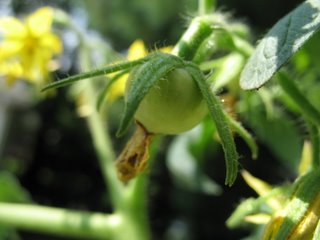Sunday, July 30, 2006
Books: The No. 1 Ladies' Detective Agency
by Alexander McCall Smith
Quick Synopsis: Set in present day Botswana, Precious Ramotswe decides to set up the first ever Ladies' Detective Agency using inheritance money from her father. Within the first few weeks of business, she's called upon to find missing husbands, recover stolen vehicles, and follow errant daughters. As her reputation grows, Mma Ramotswe is hired to solve increasingly complicated and delicate mysteries.
This is a simple, basic, and uncomplicated book perfect for long plane rides or afternoons strapped to the elliptical machine at the gym. After the opening introduction of Precious Ramotswe's character and some background on her childhood and family, the book is essentially broken down chapter-by-chapter into the individual cases Mma Ramotswe is hired to solve. On each case, Mma Ramotswe encounters a bevy of vibrant, amusing characters, each with their own special quirks and agendas. The book is set against the backdrop of Gaborone, a small village in Botswana near the Kalihari Desert, and the geography and history of this country weaves in and out of the stories being told.
Toward the middle of the book, something started nagging me. The book reminded me of something--I was sure of it. Had I read it before and forgotten as happens to even the best bibliophile from time to time. But no, I hadn't read this book before, I was sure of it. What was it? Something about the characters, the cases Mma Ramotswe is set to solve, something about it was just so familiar. It bugged me through the rest of the book, through several sessions with the elliptical machine, and all the long waits for the #39 bus last week. I finished the book and sat frowning at the cover. And then it came to me: Encyclopedia Brown. Alexander McCall Smith has succeeded in writing an Encyclopedia Brown series for adults. All it's missing are case solutions at the back of the book--remember the letters were turned around so you had to look in a mirror to read the answer? Man, I loved those books. And I loved Precious Ramotswe and the No. 1 Ladies Detective Agency in the same simple, addicted way.
Still, case solved, book finished, I was left wanting more. As much as I adored Encyclopedia Brown as a kid and can still appreciate those One Minute Mysteries for what they were, No. 1 Ladies' Detective Agency is not a children's book and was frustrating in its lack of depth. There were a few glimmers of Truly Sensitive Subjects--wife beating, children sacrificed to witch doctors, Botswana's own complicated social and political history. But every time one of these subjects was broached, Smith quickly veered the storyline back to the sunny side of the street, wrapping everything up with a laugh and a happy ending.
It was obviously not Smith's goal in writing No. 1 Ladies' Detective Agency to spark a revolution or even necessarily to increase Western sensitivity toward Botswana culture. I feel that Smith intended to write a fun, light-hearted book that portrayed both black and white Africans as regular people who deal with straying husbands, medical fraud, and rebellious teenagers just like, well, everyone else in the world. And, heck, if he inspired just one middle-class white American look up Botswana on a map, that's an added bonus. Not every book set in Africa or written by an African (black or white--Smith was born in Zimbabwe) has to tackle the cultural and ethical minefield of African history. In fact, I'm positive there are people who have religiously read every book in the No. 1 Ladies' Detective Agency series who will probably never crack the cover of books like A Long Walk to Freedom by Nelson Mandela or even The Poisonwood Bible by Barbara Kingsolver. If Smith had gone into more detail about the South African diamond trade or the possible political corruption of some of her clients, would he have lost some of these readers?
I do think that Smith missed a literary opportunity in glossing over the hard issues. Even if he chose not to engage in a discussion of African politics, there were plenty of other universally human emotions that could have been brought to the front of his writing. Exploring these issues would have added much vibrancy and urgency to Smith's otherwise emotionally level book. In particular, Mma Ramotswe's character could have benefited enormously from a dash of complexity and a bit more soul-baring. Smith almost does this in his few mentions of Mma Ramotswe's baby who died in infancy, but never quite manages more than an 'Oh...sad. Ok, moving on!" feeling. Unfortunately, none of Smith's quirky characters are ever more than just characters, and his writing never accomplishes that literary magic of fully transporting the reader into the "here and now" of the book.
Monday, July 24, 2006
Books: Emergency Book-Aid-Drop from the land of Minnesota
My mother and I share a long and (yes) fanatical devotion to young adult fantasy novels. Occasionally other sorts of young adult novels will find their way into the mix, but we're pretty exclusive. We'll read just about anything once, tend to have very similar tastes about what we've read, and have been known to discuss them far into the reaches of the phone bill (now we have the same phone plan and don't have to worry about such pithy restraints). Since Mom-bo lives in rural Minnesota, she orders most of her books online and from catalogues, and she very generously passes them on to me when she's done.
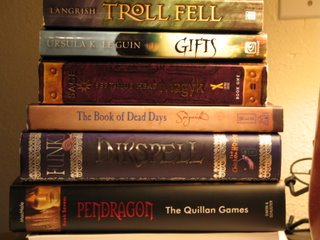 Today was a nice mix of books I was expecting (because we've been talking about them) and surprise books. They came at the perfect time because my Tamora Pierce marathon needs a bit of a mile-15 water break. Here's the run-down:
Today was a nice mix of books I was expecting (because we've been talking about them) and surprise books. They came at the perfect time because my Tamora Pierce marathon needs a bit of a mile-15 water break. Here's the run-down:Troll Fell by Katherine Langrish
Gifts by Ursula Le Guin -- Mom and I *think* this is the first YA book Ursula Le Guin has put out for a while. I've missed a few, but I think the last time I read anything new by her, I was in middle school. Muy exciting!
Septimus Heap: Magyk by Angie Sage
The Book of Dead Days by Marcus Sedgwick
Inkspell by Cornelia Funke -- This is a sequel to Inkheart, which I didn't really like. Mom thought this one was better, though, so I'll give it the old college try.
Pendragon: The Quillan Games by D.J. MacHale -- Ahhh...the long-awaited 7th book in the Pendragon series. This is soooo not your typical Arthurian legend/spin off book. There actually really aren't any connections (so far, anyways) to Arthurian legend. The main character is an American boy who is one of the "Travelers," a band of mysterious multi-universe travelers a bit a la Dr. Who. The first book started off slow, but now Mom and I are totally hooked. (P.S. Spell-check wanted to replace "Arthurian" with "earthworms." That's funny stuff.)
The other great thing about Mom Emergency Book-Drops is that she leaves great little notes on each one item included. I have a feeling if Mom-bo was ever asked to write a marketing quote for any of these books, they'd sound much like this. And she'd probably insist they be affixed to the cover via post-it note, as well.
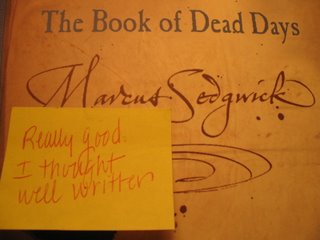
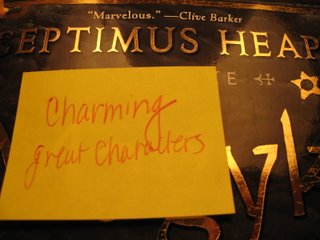
I've vowed to work through a stack of library books (some of which have already been renewed a few times...er...) before consuming these, but my discipline may waver. Stay tuned for your breaking-news updates.
Sunday, July 23, 2006
Slackdough Breads: If you can't beat 'em, join 'em...
Slackdough breads incorporate a higher percentage of water into the standard ratios of flour-water-salt-yeast--which means the extra moisture in the air on humid days isn't going to make much of a difference to your final dough. In order to develop the gluten, slackdoughs aren't so much 'kneaded' as they are mixed or folded. A lot. The final dough will be more like a thick, sticky batter instead of the smooth round ball you want when making breads like traditional whole-wheat or sourdough. It's possible to do this kind of mixing by hand, but it's generally recommended that you use a heavy-duty stand mixer. Plus, a stand mixer means you can lounge by the counter with your favorite cool summer beverage in hand, taking delicate sips as you watch the mixer do the work for you.
For my first foray into slackdoughs, I chose the recipe for "Pain a L'Ancienne" from The Bread Baker's Apprentice by Peter Reinhart. This recipe is a bit unique in that after the initial mixing of ingredients and a bit of mixer-kneading, you immediately cover the dough and put it in the refrigerator to slowly rise ("retard") overnight. This means that just as the yeast is waking up and starting to go to town, the cold in the fridge sets the yeast back at a stage of near-dormancy. Meanwhile, the amylase enzymes (watch out--vocab word!) are breaking down the starch in the flour into sugar. The next morning, when you take the dough out of the fridge and let it come to room temperature, the yeast sees all that sugar and thinks it woke up in heaven. Since not all the sugar gets converted into carbon dioxide or alcohol by the yeast, the final bread has a slightly sweet taste. (P.S. This method is also called "delayed-fermentation".) This dough can be shaped like baguette, ciabatta, pugliese, or any other shape your heart desires (except a sandwich-style loaf--they don't do so well with this dough). I decided to try a baguette-style loaf. Here's the full scoop:
Pain a L'Ancienne
Kudos go to Peter Reinhart in The Bread Baker's Apprentice for this recipe.
Ingredients:
6 cups (27 oz) unbleached bread flour
2 1/4 teaspoons (.56 oz) salt
1 3/4 teaspoons (.19 oz) yeast (instant yeast is preferred--if you use active dry yeast, let it dissolve for a few minutes in a few tablespoons of room-temperature water before adding the rest of the ingredients)
2 1/4 cups to 3 cups (19-24 oz) water, ice cold
Day 1 (the night before):

 Combine flour, salt, yeast, and 19 oz of water in the bowl of a stand mixer with the dough-hook attachment and mix for 2 minutes on a low speed. Once all the ingredients are combined, mix for 5-6 minutes on a medium speed. (*Note: Reinhart's recipe says to use the paddle attachment for the initial mixing and then switch to the dough hook for the rest of the mixing. I thought that was a little needless, so I used the dough hook for both stages.) The dough should stick to the bottom of the bowl, but release from the sides of the bowl. If it's not releasing, sprinkle a little more flour until it does. On the other hand, if the dough is really stiff and is releasing from the bottom of the bowl as well, dribble a little water onto it until you reach a happy medium. (See photos to the right.)
Combine flour, salt, yeast, and 19 oz of water in the bowl of a stand mixer with the dough-hook attachment and mix for 2 minutes on a low speed. Once all the ingredients are combined, mix for 5-6 minutes on a medium speed. (*Note: Reinhart's recipe says to use the paddle attachment for the initial mixing and then switch to the dough hook for the rest of the mixing. I thought that was a little needless, so I used the dough hook for both stages.) The dough should stick to the bottom of the bowl, but release from the sides of the bowl. If it's not releasing, sprinkle a little more flour until it does. On the other hand, if the dough is really stiff and is releasing from the bottom of the bowl as well, dribble a little water onto it until you reach a happy medium. (See photos to the right.)Lightly oil a large bowl and transfer dough into this bowl. Cover with plastic wrap and refrigerate immediately (overnight or for at least 8 hours).
Day 2:

 Remove the bowl with dough from the refrigerator and set it on the counter. Leave the dough at room temperature until it has doubled from its original size (about 2-3 hours). The surface of the dough should look puffy and dimpled. (See photos to the right.)
Remove the bowl with dough from the refrigerator and set it on the counter. Leave the dough at room temperature until it has doubled from its original size (about 2-3 hours). The surface of the dough should look puffy and dimpled. (See photos to the right.)About 45 minutes to an hour before baking, prepare the oven for baking. Make sure the oven rack is in the middle position. If you have a baking stone, place the stone on the wire rack. Place an empty steam pan (I use an old loaf pan that's seen better days) in the bottom of the oven. Pre-heat the oven to 500 degrees.
Once the dough has doubled, liberally sprinkle the counter with flour--about 1/4 cup initially with another 1/4 cup ready in the wings. Transfer the dough from the bowl to the floured counter. Try to deflate the dough as little as possible. Sprinkle some more flour on top of the dough (not an entire 1/4 cup, but enough so that the top isn't super-sticky). With both hands, stretch and shape the dough into an oval/rectangle about 8 inches long by 6 inches wide. You can sprinkle more flour on if the dough is too sticky to cooperate. Cut the dough in half width-wise with a dough scraper or butter knife. Use the blade as a pincer to pinch the dough in half rather than sawing it in half with repeated cuts. Let the dough relax on the counter for 5 minutes. (This gives the gluten in the dough time to relax and become elastic-y again.)
Lay two sheets of parchment paper on the counter top near your work area.
 With one of the dough pieces, use your dough scraper or butter knife to cut the dough into three equal lengths. As gently as possible, transfer each length to your parchment paper, leaving about three inches of space in between each piece. Stretch each piece to the desired length. (See photo at right.) Repeat with second piece of dough and place onto the second piece of parchment paper.
With one of the dough pieces, use your dough scraper or butter knife to cut the dough into three equal lengths. As gently as possible, transfer each length to your parchment paper, leaving about three inches of space in between each piece. Stretch each piece to the desired length. (See photo at right.) Repeat with second piece of dough and place onto the second piece of parchment paper.*Note: Reinhart recommends using a dough scraper dipped in cold water to separate the dough into the three lengths and then well-flouring your hands to do the transferring to the parchment paper. This didn't work so well for me, so I decided that if the scraper could be wet, my hands could be wet too. Washing my hands, shaking off the excess water, and then immediately transferring the pieces worked best for me.
Using a peel or the back of a baking sheet, slide the first set of loaves and parchment paper into the oven on top of your baking stone. (If you don't have a baking stone, leave the dough and parchment paper on top of the baking sheet.) Pour 1 cup of boiling water into the steam pan on the floor of the oven and close the door. After 30 seconds, open the oven door and spritz the inside of the oven with a squirt bottle. Repeat the spritzing twice more and then lower the oven temperature to 475 degrees.
 After about 5 minutes, check the loaves. If they aren't browning uniformly, rotate them in the oven. The loaves should cook for a total of 20 to 25 minutes and are done when the crust is a deep golden brown. If you have an instant read thermometer, you can check the internal temperature of the loaves. Internal temperature should be about 205 degrees. (See photo at right. Click on the image to enlarge and see all the detail.) Re-heat oven to 500 degrees again and repeat baking with second set of loaves.
After about 5 minutes, check the loaves. If they aren't browning uniformly, rotate them in the oven. The loaves should cook for a total of 20 to 25 minutes and are done when the crust is a deep golden brown. If you have an instant read thermometer, you can check the internal temperature of the loaves. Internal temperature should be about 205 degrees. (See photo at right. Click on the image to enlarge and see all the detail.) Re-heat oven to 500 degrees again and repeat baking with second set of loaves.Let cool for about 20 minutes and then dig in! These loaves will keep for a few days if kept in an air-tight container. You can also freeze them (wrapped in Saran wrap and then placed in a freezer-storage ziplock bag) for several months.
 My current favorite sandwich with this bread is honey-smoked ham with slices of fresh mozzarella, topped with greens and basil (from my garden, of course) and Dijon mustard. Mmm, mmm, good!
My current favorite sandwich with this bread is honey-smoked ham with slices of fresh mozzarella, topped with greens and basil (from my garden, of course) and Dijon mustard. Mmm, mmm, good!(For those following the Weight Watcher's plan, 1/2 of one loaf is 4 points before adding any toppings)
Monday, July 17, 2006
Cooking (by way of Emma's Garden)

Here's the panorama of my garden. From left to right, I have: greens (including arugula, lettuce, spring onions, and various other leafy things that came in a mix seeds packet), orange bell peppers, lavendar, rosemary, basil, mixed flowers (including snap dragons, zinneas, and miniature sunflowers), and two containers of tomatos. I had snow peas earlier in the season, but they're long gone now.
 From top to bottom to the right, a close up of a pepper flower (white) and a moth-visitor to my garden.
From top to bottom to the right, a close up of a pepper flower (white) and a moth-visitor to my garden.A close up of a tomato flower (yellow). Several of these flowers have started to fall off, so every morning I scurry in barefeet hoping to see the beginnings of a tomato. Nothing yet, but I am filled with faith and anticipation.
 A close up of a zinnea bloom and a snap dragon bloom. All these flowers were sickly at first--I had to re-start the seedling several times. Now that summer is in full swing, though, my single flower pot is a riot of green and plant-competition for sunlight. So far the zinneas are winning most of the sunlight, but the sunflowers are putting up a fight. The snap dragons seem to keep to themselves and poke out where you least expect it.
A close up of a zinnea bloom and a snap dragon bloom. All these flowers were sickly at first--I had to re-start the seedling several times. Now that summer is in full swing, though, my single flower pot is a riot of green and plant-competition for sunlight. So far the zinneas are winning most of the sunlight, but the sunflowers are putting up a fight. The snap dragons seem to keep to themselves and poke out where you least expect it.I don't have any pictures of the herbs
 cuz they're all kind of boring right now. I'm trying to be patient and coach them along, but worry about the lavendar and rosemary--especially when I walk through the farmer's market and see the vendors hawking splendid tall bushes of these herbs. The basil is slowly coming into its own, and I actually had enough leaves to sprinkle on the last pizza I made. I also just repotted some of the late-starter basil seedling, so I have high hopes for the upcoming weeks.
cuz they're all kind of boring right now. I'm trying to be patient and coach them along, but worry about the lavendar and rosemary--especially when I walk through the farmer's market and see the vendors hawking splendid tall bushes of these herbs. The basil is slowly coming into its own, and I actually had enough leaves to sprinkle on the last pizza I made. I also just repotted some of the late-starter basil seedling, so I have high hopes for the upcoming weeks.I've only had two major pest problems s
 o far. A plague of caterpillars nibbled my greens down to nubs before I thought to move the tray to a more creepy-crawly inaccessible location. This got rid of the caterpillars and had the unexpected side bonus of teaching me the value of trimming back leafy greens in order to have them grow back bushier and fuller. Thanks, caterpillars!
o far. A plague of caterpillars nibbled my greens down to nubs before I thought to move the tray to a more creepy-crawly inaccessible location. This got rid of the caterpillars and had the unexpected side bonus of teaching me the value of trimming back leafy greens in order to have them grow back bushier and fuller. Thanks, caterpillars!My battle against the aphids is on-going. At first they were just on the peppers. Then they moved over to the tomatos. And most recently, I've found them snuggled d
 eep into the lavendar. So far, I've been pretty successful at keeping them under control with soapy water spray. Emma-3. Aphids-nil. I'll keep you posted as the summer progresses.
eep into the lavendar. So far, I've been pretty successful at keeping them under control with soapy water spray. Emma-3. Aphids-nil. I'll keep you posted as the summer progresses.P.S. I took a bunch of pictures of the pepper and tomato flowers when they were at their peak, but sadly, didn't realize that my camera was on the highest resolution setting, and I had some trouble loading those pictures onto the site. So, alas, the pictures you see are of the flowers slightly past their peak. Next time you visit, I'll make sure to chain you to a chair and show you what a fantastic amateur photographer I am.
Thursday, July 13, 2006
Knitting: The Laptop Cozy
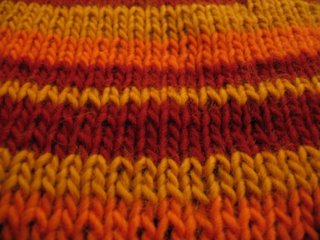 The Laptop Cozy is really very simple--it's basically a really long rectangle knit in a simple stockinette stitch and you can stripe or not as you please. Then you sew up the sides, felt it, cut some holes for handles, and voila! Laptop Cozy!
The Laptop Cozy is really very simple--it's basically a really long rectangle knit in a simple stockinette stitch and you can stripe or not as you please. Then you sew up the sides, felt it, cut some holes for handles, and voila! Laptop Cozy!I'm partial to stripes myself and it just so happens that I had some Lamb's Pride Worsted yarn left in my stash from some socks that...um...were going to be Christmas presents, but...um...didn't quite make it beyond the Threshold of Good Intention. I lacked two skeins in a matching color, so on my Saturday morning jog a few weeks ago, I ran to my local yarn store, A Good Yarn (off Harvard Street in Brookline) to pick some up. The well-mannered ladies presiding over the shop that morning didn't quite know what to make of this sweaty, wild-eyed knitter who stumbled into their midst. "I won't touch!" I promised, and they nodded sagely.

Home, showered, and settled with some coffee, I began the Laptop Cozy. It's about half done now, so nothing too exciting to see. But I just happened to have recently purchased a fancy camera, so of course I'll post a few pictures so you can see the excellent striping action. By the way, the gold is the yarn I bought on my jog. I'm still learning how to do the macro-shots, so the colors are a bit dull, but you get the idea.
Look! A SUPER macro shot! Oh, the fine textures and textiles.
Tuesday, July 04, 2006
Baking: Pizza time!
Home-made Thin Crust Pizza Dough
Makes 2 pizzas--serving size ~1/2 pizza
3/4 c. + 2 tsp (6.2 oz.) water (warm but not scalding)
1/2 tsp. yeast
2 c. (10 oz.) unbleached all-purpose flour
1/2 tsp salt
Pour water (already warmed) into a medium-sized mixing bowl. Add yeast and allow to dissolve for a few minutes. Stir in flour 1/2 cup at a time, reserving about 1/2 cup for kneading, until the dough forms into a shaggy, clumpy mass (yes, those are scientific terms).
Pour the rest of the flour (1/2 cup) onto a clean counterspace and turn the dough out onto the flour. Turn the dough a few times to coat with flour and then knead until all the flour is incorporated and the dough is smooth and silky to the touch. The dough should still feel moist and slightly tacky, but if it's sticking to your hands and countertop like bubble gum (and like mine did in the humidity this afternoon) work in more flour one tablespoon at a time until it's smooth and silky. Total kneading time should be five minutes or less. Since we're not making bread dough, we don't need to worry about developing the gluten (gluten is what helps bread dough to become elastic and take shape--more on this in future posts). In fact, if you want an extra crispy crust, very minimal gluten-formation is even better.
Divide the dough in two and place each piece into large ziplock bags or tupperware containers. Refrigerate overnight and use within 48 hours. (That's the planning ahead part. In a pinch, I've made the dough in the morning or early afternoon and refrigerated it until dinner time. The longer it has to sit in the fridge, the more the flavor is developed, but honestly, pizza is good no matter what, right?!)
*Note: The Cook's Illustrated version (and just about every other pizza dough recipe I've found) includes a lot more ingredients in the dough, particularly olive oil and sugar. Olive oil will make your final product more tender. Sugar helps the yeast to grow and multiply, and also, obviously, makes your final product sweeter. None of these ingredients is truly necessary to make the dough 'work,' and are primarily there to add flavor and texture. I like to keep my recipes as basic as possible, primarily because I just happen to like the pure bread flavor, and also because the basic taste of the dough balances the complex flavors in the pizza toppings. Feel free to experiment with other ingredients if you like!
Making the Pizza
About 30 minutes to 1 hour before baking, pre-heat your oven to 500 degrees. If you have a baking stone (which I recommend--again, more on this in future posts) make sure that it's on a rack in the low to middle level.
Remove the dough from the refrigerator and from the plastic bag, and set it on a clean part of your counter. Cover and let sit for about 10 minutes while you prepare the toppings.
Set a large piece of parchment paper on the counter. Work the dough in your hands and form into a large disk. I haven't quite yet accomplished the pizzeria method of twirling the dough in the air, but I'm working on it. Lay the disk of dough on the parchment paper. Working from the middle of the dough out, continue to stretch the dough until it's about 1/4 of an inch or less thick all over. The dough will stick to the parchment paper, but that's ok. Every so often, pull the edges of the parchment paper so the dough lies flat. I haven't quite achieved the perfect circular pie crust yet--most of mine end up looking like one of the Great Lakes, but I just call it Culinary License and have done with it.
For pizza sauce, I use crushed tomatoes with Italian spices. Many recipe recommend simmering the crushed tomatoes until they thicken, but I think it doesn't actually make much difference. If you've got the time and the inclination, go for it. If not, spoon a few table spoons onto your dough straight from the can. Cover with all your favorite toppings EXCEPT THE CHEESE. See my toppings suggestions below, but we've all had pizza, so pile on your favorites.
Using a bread peel (long paddle-like thing you see decorating the walls at Bertucci's--yes, people actually do use them!) or the backside of a baking sheet, slide your pizza still on the parchment into the oven. If you don't have a baking stone, just bake on a baking sheet.
Bake for about 5 minutes and then rotate the pizza for even baking (most ovens have 'hot spots' and whatever you're baking will bake un-evenly if it's not rotated). Bake for another 3 minutes and then sprinkle the cheese over the top. Bake for another 2-3 minutes until the edges are golden brown and crispy. Remove from oven and let cool on a wire rack. At this point, you can slide the parchment paper out from under the pizza. Let cool for about five minutes (I know it's hard to wait!) and serve.
Topping Suggestions
1/2 red pepper cut into strips--raw
1/2 onion cut into strips and sauteed
mushrooms cut into slices
Most meats work well: pepperoni, sausage, chunks of chicken, steak, etc.
Most cheeses also work well: mozzarella, Parmesan, feta, gorgonzola, etc.
My current favorite combo is very thin round slices of potato topped with arugula and gorgonzola cheese. Mmmmm, good!
*A note for those among us watching our figures: The lack of oil in the pizza dough means the only thing truly adding fat and calories are the meats and the cheese. If you're following the Weight Watcher's plan, 1/2 of one pizza is about 4 points before you add toppings. Crushed tomatoes (as the sauce) is zero points. Most veggies are zero points. I usually top my pizza with about 14 grams of cheese per half, which is roughly 1 point. Sargento makes a great line of reduced-fat, pre-shredded cheese mixes which are all exactly 1 point for 14 grams. It might not sound like a lot, but a little flavor can go a long way. Pile on those veggies and you've got a great filling meal for about 5 points.
Monday, July 03, 2006
Bread-a-thon
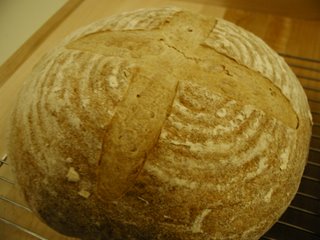
Baking: Bread+Summer=Ick
And is it worth it? Well, actually, yes. Coming home from buying groceries this afternoon to a house that smelled of fresh bread was as close to bliss as it gets.
My newest bread-baking magic trick to counteract the summer gross-ness is making the dough and doing the first rise the night before (when it's theoretically cooler). Then I shape the loaves, cover with Saran wrap, and stick them in the fridge overnight. Since my boyfriend gets up much earlier than I do on weekends, I have him take the loaves out of the fridge and put them on the counter. By the time I struggle out of bed a few hours later, they have proofed nicely and all I have to do is heat up the oven and bake--all before it gets ridiculously hot outside.
Experiment # 1 (last night/this morning) was a success. Still lots of bubble-gum action last night, but I think my kitchen only dropped down to the second ring of hell this morning when I had the oven on. My backup plan is stocking the freezer with extra loaves so when the weather is extra yucky, I can just let a loaf thaw on the counter and go have a mojito on the backporch. How's that for usin' the ol' noodle?!
